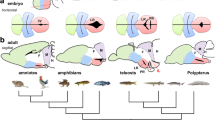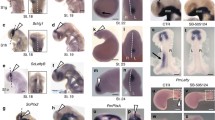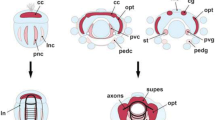Abstract
The living monotremes (platypus and echidnas) are distinguished from therians as well as each other in part by the unusual structure of the thalamus in each. In particular, the platypus has an enlarged ventral posterior (VP) nucleus reflecting the great behavioural importance of trigeminosensation and electroreception. The embryological collections of the Museum für Naturkunde in Berlin were used to analyse the development of the dorsal thalamus and ventral thalamus (prethalamus) in both species. Prosomeric organization of the forebrain emerged at 6 mm crown-rump length (CRL), but thalamic neurogenesis did not commence until about 8–9 mm CRL. Distinctive features of the dorsal thalamus in the two species began to emerge after hatching (about 14–15 mm CRL). During the first post-hatching week, dense clusters of granular cells aggregated to form the VP of the platypus, whereas the VP complex of the echidna remained smaller and divided into distinct medial and lateral divisions. At the end of the first post-hatching week, the thalamocortical tract was much larger in the platypus than the echidna. The dorsal thalamus of the platypus is essentially adult-like by the sixth week of post-hatching life. The similar appearance of the dorsal thalamus in the two species until the time of hatching, followed by the rapid expansion of the VP in the platypus, is most consistent with ancestral platypuses having undergone changes in the genetic control of thalamic neurogenesis to produce a large VP for trigeminal electroreception after the divergence of the two lineages of monotreme.






Similar content being viewed by others
References
Altman J, Bayer SA (1979a) Development of the diencephalon in the rat. IV. Quantitative study of the time of origin of neurons and internuclear chronological gradients in the thalamus. J Comp Neurol 188:455–472
Altman J, Bayer SA (1979b) Development of the diencephalon in the rat. VI. Re-evaluation of the embryonic development of the thalamus on the basis of thymidine-radiographic datings. J Comp Neurol 188:501–524
Altman J, Bayer SA (1988a) Development of the rat thalamus: I. Mosaic organization of the thalamic neuroepithelium. J Comp Neurol 275:346–377
Altman J, Bayer SA (1988b) Development of the rat thalamus: II. Time and site of origin and settling pattern of neurons derived from the anterior lobule of the thalamic neuroepithelium. J Comp Neurol 275:378–405
Altman J, Bayer SA (1988c) Development of the rat thalamus: III. Time and site of origin and settling pattern of neurons of the reticular nucleus. J Comp Neurol 275:406–428
Andres KH, von Düring M, Iggo A, Proske U (1991) The anatomy and fine structure of the echidna Tachyglossus aculeatus snout with respect to its different trigeminal sensory receptors including the electroreceptors. Anat Embryol 184:371–393
Ashwell KWS (2010) Diencephalon and associated structures: prethalamus, thalamus, hypothalamus, pituitary gland, epithalamus, and pretectal area. In: Ashwell KWS (ed) The neurobiology of Australian marsupials. Cambridge University Press, Cambridge, pp 95–118
Ashwell KWS, Paxinos G (2005) Cyto- and chemoarchitecture of the dorsal thalamus of the monotreme Tachyglossus aculeatus, the short-beaked echidna. J Chem Neuroanat 30:161–183
Ashwell K, Marotte LR, Mai JK (2010) Atlas of the brain of the developing tammar wallaby (Macropus eugenii). In: Ashwell KWS (ed) The neurobiology of Australian marsupials. Cambridge University Press, Cambridge, pp 245–248
Camens AB (2010) Were early tertiary monotremes really all aquatic? Inferring paleobiology and phylogeny from a depauperate fossil record. Proc Natl Acad Sci USA 107:E12
Divac I, Holst MC, Nelson J, McKenzie JS (1987a) Afferents of the frontal cortex in the echidna (Tachyglossus aculeatus). Indication of an outstandingly large prefrontal area. Brain Behav Evol 30:303–320
Divac I, Pettigrew JD, Holst MC, McKenzie JS (1987b) Efferent connections of the prefrontal cortex of echidna (Tachyglossus aculeatus). Brain Behav Evol 30:321–327
Gregory JE, Iggo A, McIntyre AK, Proske U (1987) Electroreceptors in the platypus. Nature 326:386–388
Gregory JE, Iggo A, McIntyre AK, Proske U (1988) Receptors in the bill of the platypus. J Physiol 400:349–366
Gregory JE, Iggo A, McIntyre AK, Proske U (1989) Responses of electroreceptors in the snout of the echidna. J Physiol 414:521–538
Griffiths M (1978) The biology of the monotremes. Academic, New York
Griffiths M, McIntosh DL, Coles REA (1969) The mammary gland of the echidna, Tachyglossus aculeatus, with observations on the incubation of the egg and on the newly hatched young. J Zool (Lond) 158:371–386
Hawkins M, Battaglia A (2009) Breeding behaviour of the platypus (Ornithorhynchus anatinus) in captivity. Aust J Zool 57:283–293
Holland N, Jackson SM (2002) Reproductive behaviour and food consumption associated with the captive breeding of platypus (Ornithorhynchus anatinus). J Zool (Lond) 256:279–288
Hughes RL, Hall LS (1998) Early development and embryology of the platypus. Phil Trans R Soc Lond B Biol Soc 353:1101–1114
Jones EG (2007) The thalamus, 2nd edn. Cambridge University Press, Cambridge
Manger PR, Hughes RL (1992) Ultrastructure and distribution of epidermal sensory receptors in the beak of the echidna, Tachyglossus aculeatus. Brain Behav Evol 40:287–296
Manger PR, Pettigrew JD (1996) Ultrastructure, number, distribution and innervation of electroreceptors and mechanoreceptors in the bill skin of the platypus, Ornithorhynchus anatinus. Brain Behav Evol 48:27–54
Manger PR, Hall LS, Pettigrew JD (1998) The development of the external features of the platypus (Ornithorhynchus anatinus). Phil Trans R Soc Lond B Biol Sci 353:1115–1125
Mikula S, Manger PR, Jones EG (2008) The thalamus of the monotremes: cyto- and myeloarchitecture and chemical neuroanatomy. Phil Trans R Soc Lond B Biol Sci 363:2415–2440
Musser AM (2003) Review of the monotreme fossil record and comparison of paleontological and molecular data. Comp Biochem Physiol A Mol Integr Physiol 136:927–942
Pettigrew JD (1999) Electroreception in monotremes. J Exp Biol 202:1447–1454
Phillips MJ, Bennett TH, Lee MSY (2009) Molecules, morphology, and ecology indicate a recent, amphibious ancestry for echidnas. Proc Natl Acad Sci USA 106:17089–17094
Proske U, Gregory JE, Iggo A (1998) Sensory receptors in monotremes. Phil Trans R Soc Lond B Biol Sci 353:1187–1198
Puelles L, Rubenstein JLR (1993) Expression patterns of homeobox and other putative regulatory genes in the embryonic mouse forebrain suggest a neuromeric organization. Trends Neurosci 16:472–479
Puelles L, Rubenstein JLR (2003) Forebrain gene expression domains and the evolving prosomeric model. Trends Neurosci 26:469–476
Regidor J, Divac I (1987) Architectonics of the thalamus in the echidna (Tachyglossus aculeatus): Search for the mediodorsal nucleus. Brain Behav Evol 30:328–341
Renfree MB, Papenfuss AT, Shaw G, Pask AJ (2009) Eggs, embryos and the evolution of imprinting: insights from the platypus genome. Reprod Fertil Dev 21:935–942
Rismiller PD, McKelvey MW (2003) Body mass, age and sexual maturity in short-beaked echidnas, Tachyglossus aculeatus. Comp Biochem Physiol A Mol Integr Physiol 136:851–865
Scheich H, Langner G, Tidemann C, Coles RB, Guppy A (1986) Electroreception and electrolocation in platypus. Nature 319:401–402
Werneburg I, Sánchez-Villagra MR (2011) The early development of the echidna, Tachyglossus aculeatus (Mammalia: Monotremata), and patterns of mammalian development. Acta Zool 92:75–88
Zeller U (1989) Die Entwicklung und Morphologie des Schadels von Ornithorhynchus anatinus: (Mammalia, Prototheria, Monotremata). Abhandlungen der Senckenbergischen Naturforschenden Gesellschaft
Acknowledgments
The Alexander von Humboldt Foundation generously provided financial support for this project, making it possible to perform an extensive analysis of the Museum für Naturkunde (MfN) embryological collections. I am particularly in debt to Dr Peter Giere of the MfN, whose kind and considerate help in accessing the collection and using the museum equipment was invaluable. I am also very grateful to Professor Ulrich Zeller of the MfN for helpfully providing access to his collection of sectioned platypus and echidna heads.
Author information
Authors and Affiliations
Corresponding author
Rights and permissions
About this article
Cite this article
Ashwell, K.W.S. Development of the dorsal and ventral thalamus in platypus (Ornithorhynchus anatinus) and short-beaked echidna (Tachyglossus aculeatus). Brain Struct Funct 217, 577–589 (2012). https://doi.org/10.1007/s00429-011-0364-3
Received:
Accepted:
Published:
Issue Date:
DOI: https://doi.org/10.1007/s00429-011-0364-3




